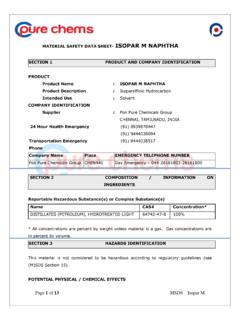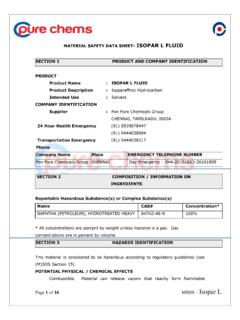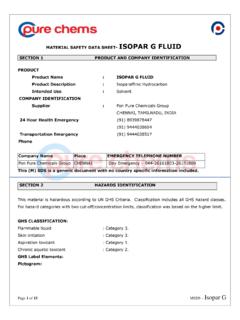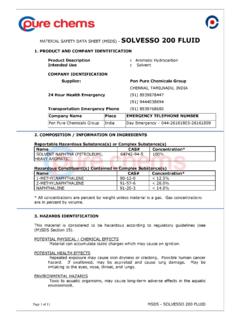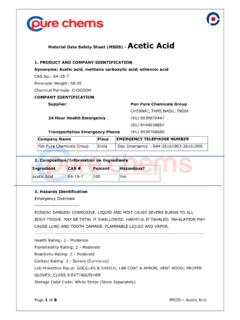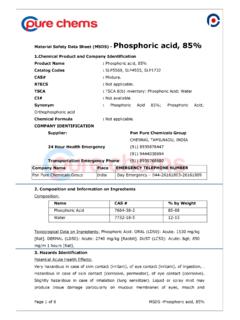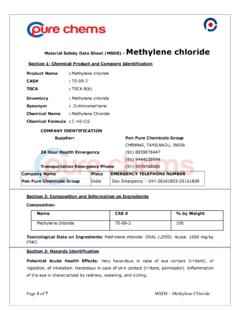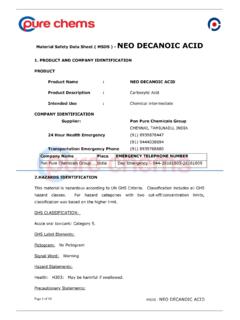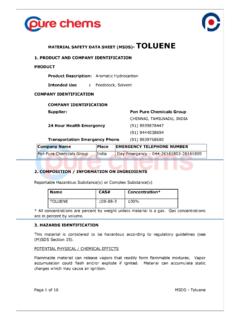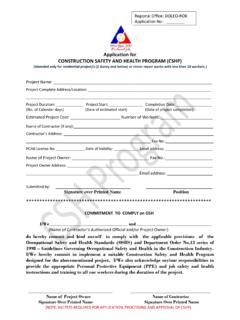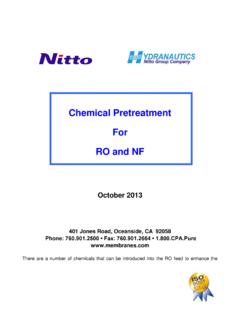Transcription of Material Safety Data Sheet (MSDS) - PERCHLOROETHYLENE
1 Page 1 of 7 MSDS PERCHLOROETHYLENE Material Safety Data Sheet (MSDS) - PERCHLOROETHYLENE 1. IDENTIFICATION OF THE SUBSTANCE/PREPARATION AND OF THE COMPANY/UNDERTAKING Identification of the substance or preparation Product name: PERCHLOROETHYLENE Chemical name: Tetrachloroethylene Use of the substance/preparation solvent COMPANY IDENTIFICATION Supplier: Pon Pure Chemicals Group CHENNAI, TAMILNADU, INDIA 24 Hour Health Emergency (91) 8939878447 (91) 9444038694 Transportation Emergency Phone (91) 8939768680 Company Name Place EMERGENCY TELEPHONE NUMBER Pon Pure Chemicals Group India Day Emergency 044-26161803-26161809 2. HAZARDS IDENTIFICATION Application of the classification rules in GHS PHYSICAL HAZARDS Flammable liquid not classified Self-reactive substances and mixtures not classified Pyrophoric liquid not classified Corrosive to metals not classified HEALTH HAZARDS Acute toxicity(oral) Not classified Acute toxicity(Dermal)
2 Not classified Skin corrosion and irritation Category 2 Serious eye damage and eye irritation Category 2A Germ cell mutagenicity Category2 Carcinogenicity Category 1B Reproductive toxicity Category 1B Specific target organ systemic toxicity after single exposure Category 3 Specific target organ systemic toxicity after repeated Exposure Category 1 Aspiration toxicity Category 2 HAZARDOUS TO THE AQUEOUS ENVIRONMENT Acute Category 2 Chronic Category 2 Page 2 of 7 MSDS PERCHLOROETHYLENE Signal word Danger Hazard statement Causes skin irritation Causes serious eye irritation Suspected of causing genetic defects May cause cancer May damage fertility or the unborn child May cause respiratory irritation May cause drowsiness or dizziness. Causes damage to organs May be fetal if swallowed and enters airway Toxic to aquatic life Toxic to aquatic life with long lasting effects 3.
3 COMPOSITION / INFORMATION ON INGREDIENTS Components CAS-No Name % Weight 127-18-4 Tetrachloroethylene >99 4. FIRST-AID MEASURES Inhalation: Remove the victim from the contamination immediately to fresh air and keep the victim warm and quiet. Obtain medical attention immediately. If breathing is weak, irregular or has stopped, loosen his collar and belt and administer artificial respiration. Skin Contact: Remove all contaminated clothing, shoes and socks from the affected areas as quickly as possible, cutting them off if necessary. Wash the affected area with plenty of water using a mild soap or a detergent for skin. If irritation persists, obtain medical attention immediately. Eye Contact: Immediately flush eyes with running water at least 15 minutes.
4 Hold eyelids open during flushing. If irritation persists, repeat flushing. Obtain medical attention immediately. Ingestion: DO NOT induce vomiting. If spontaneous vomiting occurs, have victim lean forward with head down to avoid breathing in of vomits Keep an unconscious person the patient in the lateral position in the transportation. Obtain medical attention immediately. 5. FIRE-FIGHTING MEASURES Suitable extinguishing media: Use media appropriate for surrounding fire and/or materials. Dry chemical powder, form or carbon dioxide. No self-combustibility. Unsuitable extinguish media/methods: none Hazardous combustion product or gases: Hydrogen chloride, phosgene. Special protective equipment for fire fighters: Fire fighters should use Page 3 of 7 MSDS PERCHLOROETHYLENE pressure-demand self contained breathing apparatus due to possible exposure to hydrogen chloride and phosgene gases.
5 Additional Information: Shut off fuel to fire if possible to do so without hazard. Vapours concentrated in a confined or poorly-ventilated area can be ignited upon contact with a spark, flame or high-intensity source of heat. This can occur at concentrations in air of approximately 6. ACCIDENTAL RELEASE MEASURES Personal precautions: Ensure adequate ventilation. Unprotected personnel should move upwind of spill. Evacuate non essential personnel. Only personnel equipped with proper respiratory and skin/eye protection should be permitted in area. Environmental precautions: Shut off source of ignition and ventilate pill area. Do not wash away into shower or waterway. Take precautions as necessary to prevent contamination of ground and surface waters. Methods for cleaning up/taking up: Sweep up to avoid slipping hazard and dispose of in accordance with applicable regulations.
6 Recover or absorb spilled Material on sawdust or vermiculite and sweep into closed containers for disposal. Additional information: Information for safe handling looks up chapter 7. Information for disposal looks up chapter 13. 7. HANDLING AND STORAGE Handling In doors, use with sufficient ventilation to keep employee exposure below recommended limits. Avoid leak, overflow and dispersal. Prevent form vapour. In case of chance exposure to this substance wear suitable protective glove, eye protection and respiratory equipment. Keep upwind of work area. Do not allow product to contact open flame or electrical heating elements because dangerous decomposition products may form. Keep container tightly closed when in not use. Waste fluid takes up and place in closed containers for disposal.
7 Use floor Material which is able to prevent soil infiltration. To avoid cracks of floor. Mechanical ventilation should be used in low places because vapour is times as heavy as air. Storage Store in cool, dry, well ventilated location. Keep away from sunlight. Keep container tightly closed. Prevent spills from entering sewers, watercourses or low areas. Use floor Material which is able to prevent soil infiltration. Build roof or cover by vinyl Sheet in the case of storage container in an outdoor location. Page 4 of 7 MSDS PERCHLOROETHYLENE 8. EXPOSURE CONTROL / PERSONAL PROTECTION Ingredients with occupational exposure limits to be monitored Material : Tetrachloroethylene stabilized CAS No. 127-18-4 ACGIH(2007) TLV-TWA: N/E MAK(2006): Carcinogenic Substance.
8 The database is insufficient for the establishment of a MAK . Exposure controls occupational exposure controls Engineering Controls: Local exhaust ventilation required. Personal protection: Respiratory Protection : A NIOSH/MSHA-approved air-purifying respirator equipped with organic vapor cartridges for concentrations up to 500 ppm. An air-supplied respirator if concentrations are higher or unknown. Eye Protection : Use chemical Safety goggles when there is potential for eye contact. Skin protection : Impervious gloves Other protection : If need, protective clothing and rubber boot should be used. 9. PHYSICAL AND CHEMICAL PROPERTIES Appearance and Odour: Colourless liquid with ether-like odour. Boiling Point : Specific Gravity (H2O = 1): Vapour Pressure : (20 ) Melting Point : Vapour Density (Air = 1): Evaporation Rate (Ethyl ether = 1): Solubility in Water : g/100ml ( ) 10.
9 STABILITY AND REACTIVITY Conditions to avoid: Open flames, hot glowing surfaces, or electric arcs. Stability: Stable Materials to avoid (Incompatibilities): May react violently with alkali and alkaline earth metals such as sodium, potassium and barium. Avoid mixing with caustic soda, caustic potash, or oxidizing materials. Hazardous decomposition products: Hydrogen chloride, phosgene. Risk of flash and explosion in the case of contact high energy igniters or oxygen in concentrated amount atmosphere. May form toxicity gases by decomposition. The substance decomposes on contact with strong alkali producing dichloroacetylene, which increases fire hazard. Reacts violently with metal powders such as magnesium, aluminium, titanium, and barium.
10 Slowly decomposed by light in presence of moisture, with formation of corrosive hydrochloric acid. Page 5 of 7 MSDS PERCHLOROETHYLENE 11. TOXICOLOGICAL INFORMATION Health Hazardous (Acute and Chronic): Animal Data: -- Irritation (skin, rabbit) 810 mg/24h; Severe -- Irritation (skin, rabbit) 500 mg/24h; Mild -- Irritation (eye, rabbit) 162 mg; Mild -- Irritation (eye, rabbit) 500 mg/24h; Mild -- LD50 (oral, rat) = 2,629 mg/kg -- LD50 (oral, mouse) = 8,100 mg/kg -- LC50 (inhalation, rat) = 34,200 mg/m3/8h -- LC50 (inhalation, mouse) = 5200 ppm/4h Mutagenicity Data: -- Ames Assay; Positive -- Chromosome Aberration; Positive Carcinogenicity NTP: b IARC Monographs: 2A; Dry Cleaning OSHA Regulated: N/E This substance causes cancer in mice, and there is no evidence that it is a carcinogen in rats.
